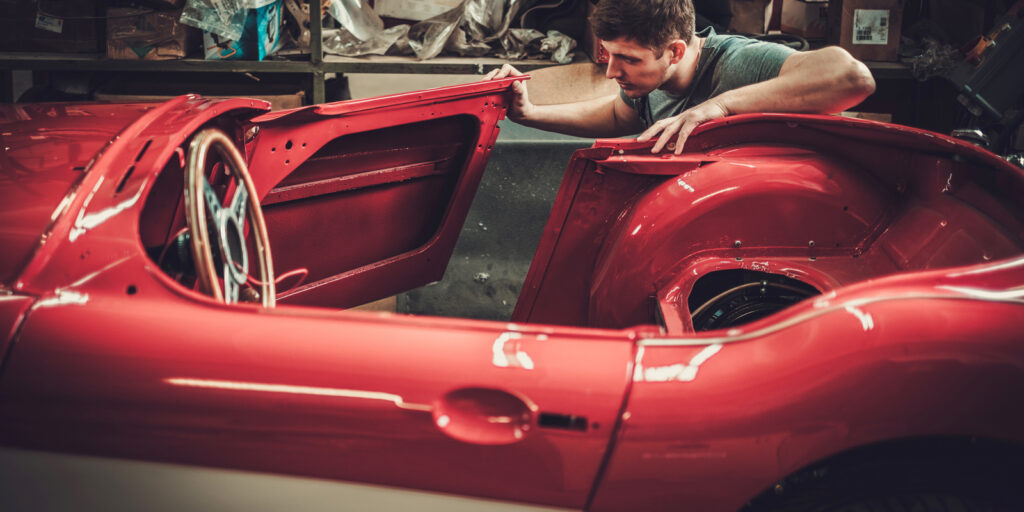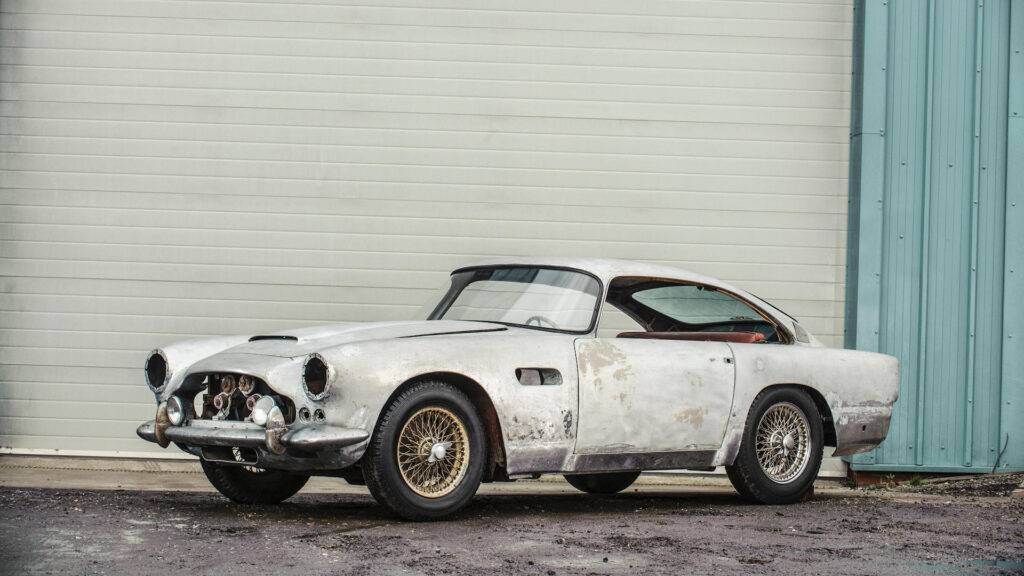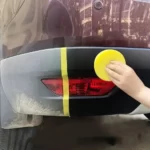Restoring a car can range from $1,000 to $100,000, depending on the vehicle’s condition and the level of restoration desired. The cost to restore a car can be influenced by the model, make, and availability of parts.
Table of Contents
ToggleRestoring a classic or vintage car can be a fulfilling experience, but it also comes at a cost. The price to restore a vehicle can vary widely based on the extent of the project, quality of parts, and labor. Factors like rust removal, engine rebuild, interior upholstery, and painting can impact costs.
Researching and budgeting carefully before embarking on a car restoration project to ensure it aligns with your financial resources and vision for the vehicle is essential.

Credit: robscustoms.com
Factors Affecting Restoration Costs
Restoring a car can be costly, and the total cost is influenced by factors such as the extent of damage, rarity of parts, labor hours, and quality of materials used. Each of these factors contributes to determining the final restoration costs.
Factors Affecting Restoration Costs Restoring a car to its former glory is a labor-intensive process that requires expertise and resources. The cost of classic car restoration can vary significantly based on various factors. Let’s explore the key factors influencing the cost of restoring a car.
Type And Condition Of The Car
The type and condition of the car play a crucial role in determining the restoration costs. Generally, rare and classic vehicles incur higher restoration expenses due to the scarcity of parts and the need for specialized craftsmanship. On the other hand, more common models may have readily available parts, resulting in lower restoration costs. The overall condition of the car also affects the restoration costs. A vehicle in better condition may require less extensive work, thus reducing the overall cost.
Extent Of Restoration Needed
The extent of restoration needed is another critical factor that impacts the overall cost. Some vehicles may require only minor repairs and cosmetic updates, while others may need a complete overhaul. Extensive restoration projects involve engine rebuilds, chassis repairs, and interior refurbishments, which can significantly increase the cost. Evaluating the car’s requirements is essential to understanding the potential restoration costs. When assessing the extent of restoration needed, it is necessary to consider aspects such as bodywork, mechanical systems, electrical components, and interior upholstery. Each area may require varying attention and expenditure to bring the car back to its original condition. In addition, the level of customization desired may also impact the restoration cost. If you aim for a personalized restoration with unique modifications and upgrades, it’s essential to factor in the additional expenses of sourcing specialized parts and skilled labor. Understanding the factors that affect car restoration costs is crucial for individuals considering such projects. By assessing the type and condition of the car and determining the extent of restoration needed, enthusiasts can ensure they have a realistic expectation of the overall cost involved. Remember, while restoring a car can be a costly endeavor, the end result is a meticulously revived piece of automotive history that can bring immense joy and pride.

Credit: vehq.com
Cost Estimation
When estimating the cost of restoring a classic car, it is essential to consider various factors. Understanding the breakdown of expenses can help you budget effectively and make informed decisions throughout restoration.
Labor Costs
Labor costs are a significant component of the overall cost of classic car restoration. The expense varies based on the specific tasks involved, such as bodywork, mechanical repairs, and painting. Skilled professionals often charge between $50 and $100 per hour for restoration work, with more specialized technicians commanding higher rates.
Parts And Materials Costs
Parts and materials costs encompass various items, from replacement mechanical components to interior upholstery and exterior trim pieces. Researching prices from reputable suppliers can help you gauge the potential expenses accurately. Car restoration costs for parts and materials can range from $5,000 to $15,000, depending on the vehicle’s make and model.
Additional Expenses To Consider
- Storage fees: If the restoration project takes an extended period, storage costs for the vehicle must be factored in.
- Transportation: Transporting the vehicle to various workshops or specialists may require additional funding.
- Unforeseen repairs: It’s crucial to allocate funds for unexpected repairs or hidden issues that may arise during restoration.
Diy Vs. Professional Restoration
Restoring a classic car is a labor of love, but necessary decisions must be made along the way, particularly when considering the restoration cost. One critical decision is whether to pursue DIY restoration or opt for professional restoration services. Both options have their own set of pros and cons, as well as distinct benefits. Here, we’ll explore the advantages and disadvantages of each to help you weigh your options.
Pros And Cons Of Diy Restoration
Undertaking the restoration of a classic car in DIY style can be a rewarding and cost-effective endeavor for those with the necessary skills and time to commit. However, it also comes with its own set of challenges and limitations.
- Pros of DIY restoration:
- Opportunity for a hands-on learning experience
- Cost savings on labor
- Control over the restoration process
- Cons of DIY Restoration:
- Requirement of specialized skills and tools
- Time-consuming and labor-intensive
- Potential for errors and rework
Benefits Of Professional Restoration
Professional restoration services offer a range of benefits that can justify the higher classic car restoration cost associated with this option. While it may require a more considerable financial investment, the outcome can often surpass the results achievable through DIY efforts.
- Benefits of Professional Restoration:
- Access to expert craftsmanship and specialized equipment
- Saving time and effort
- Potential for greater resale value
Budgeting And Financial Planning
Restoring a classic car can be an exciting project, but it’s essential to have a well-defined budget in place to avoid any unexpected costs. Whether you plan to restore a vintage Mustang or a classic Corvette, setting a realistic budget is the first step toward completing your project. In this article, we will discuss how to establish a budget for your classic car restoration and explore various financing options that can help you bring your dream car back to life.
Setting A Realistic Budget
Before embarking on your classic car restoration journey, evaluating your financial situation and setting a budget that aligns with your resources is crucial. Here are a few steps to help you determine a realistic budget:
- Evaluate the car’s condition: Assess the vehicle’s current state and make a comprehensive list of all the repairs, replacements, and upgrades it requires. This will give you an idea of the total expenses involved in the restoration process.
- Research the market: Take some time to research the average costs associated with restoring similar models. This will give you a ballpark figure to work with and help you gauge whether your budget is within a reasonable range.
- Factor in additional costs: Besides the standard restoration expenses, it’s essential to account for unexpected costs that may arise during the process. Leaving a buffer in your budget for contingencies will ensure you have the necessary funds to handle any surprises.
- Prioritize your goals: Identify your priorities for the restoration project. Determine which aspects of the car are most important to you, such as the engine, interior, or exterior. This will help you allocate your budget accordingly and avoid overspending in less significant areas.
Securing Financing Options
Once you have determined your budget, you may find that securing financing is necessary to cover the costs of your classic car restoration. Here are a few financing options to consider:
- Personal Savings: If you have significant savings earmarked for this project, using your personal funds may be a viable option. However, it’s essential to only allocate a portion of your savings that you are comfortable parting with, considering the risks and uncertainties that may arise during the restoration process.
- Loans: Traditional auto loans are a common way to finance a classic car restoration. However, it’s essential to carefully review the terms and interest rates offered by different lenders to ensure you select the most favorable option for your financial situation.
- Credit Cards: Depending on the extent of your restoration project, using credit cards with favorable interest rates and rewards programs may be a practical option. However, it’s crucial to consider the potential risks of accumulating high-interest debt.
- Specialized Restoration Financing: Some financial institutions offer financing options for classic car restoration projects. These programs are tailored to the unique needs of car enthusiasts and often provide competitive rates and flexible repayment terms.
Before choosing a financing option, consider the interest rates, repayment terms, and eligibility requirements to ensure they align with your budget and financial goals.
Maximizing Value And Maintaining Costs
When restoring a classic car, it is essential to balance maximizing its value and managing costs effectively. By implementing strategies for preserving restoration value and adopting long-term cost management techniques, you can ensure your car restoration project remains within budget while maintaining its worth.
Strategies For Preserving Restoration Value
Preserving the value of your car restoration is crucial, especially if you plan to sell the vehicle. Here are some strategies to consider:
- Thorough Research: Before starting the restoration process, conduct thorough research to understand your car model’s specific needs and requirements. This will help you make informed decisions and avoid costly mistakes.
- Authenticity: Stay true to your classic car’s original design and specifications. Using genuine parts, maintaining the appropriate color scheme, and preserving unique features will enhance the value of your restoration project.
- Professional Expertise: Seek the services of experienced professionals specializing in classic car restoration. Their knowledge and skills will ensure that the restoration work is done to a high standard, maximizing the value of your vehicle.
- Meticulous Documentation: Keep detailed records of the restoration process, including invoices, receipts, and photographs. This documentation will showcase the efforts and investments made, increasing the car’s perceived value.
Long-term Cost Management
Managing the costs associated with your car restoration project is essential to preventing overspending. Here are some long-term cost management techniques:
- Budget Planning: Develop a comprehensive budget that outlines all estimated expenses, including parts, labor, and any unforeseen issues that may arise during the restoration process.
- Prioritize and Phase: Break down your restoration project into phases, prioritizing the most critical aspects. This lets you spread the costs over time and focus on completing essential tasks first.
- Regular Maintenance: Invest in regular maintenance of your restored car to prevent major breakdowns and costly repairs in the future. This will also help preserve the value of your investment over time.
- DIY Approach: Consider taking a do-it-yourself approach for tasks that do not require specialized expertise. You can significantly reduce labor costs by learning and completing specific restoration tasks yourself.
- Insurance Coverage: Obtain comprehensive insurance coverage for your restored car. This protects your investment and provides financial assistance for unforeseen damages or accidents.
By following these strategies for preserving restoration value and implementing long-term cost management techniques, you can ensure that your car restoration project remains financially viable while maximizing its worth.

Credit: bidgarage.com
Frequently Asked Questions On the Cost of Restoring A Car
How Much Does It Cost to Restore a Car?
The cost to restore a car can vary depending on factors such as the vehicle’s condition, the extent of restoration needed, and the specific parts and labor required. Generally, car restoration costs can range from a few thousand to tens of thousands.
What Affects the Cost of Car Restoration?
Several factors can influence the cost of car restoration, including the car’s make and model, the availability and cost of replacement parts, the complexity of the restoration project, and the expertise and hourly labor rates of the professionals involved in the restoration process.
Is it worth restoring a car?
Whether restoring a car is worth it depends on various factors, such as the sentimental value of the vehicle, the rarity or historical significance of the car, and the owner’s budget and personal preference. Restoring a car can be labor-intensive and expensive, so careful consideration is necessary before a restoration project.
How long does car restoration take?
The duration of a car restoration project can vary significantly based on the car’s condition, the complexity of the restoration tasks, and the availability of parts and resources. It is not uncommon for full car restorations to take several months or even years to complete, particularly for vintage or classic vehicles.
Conclusion
The cost to restore a car can vary greatly depending on various factors, such as the make and model, damage extent, and desired restoration level. From sourcing parts to labor costs, planning, and budgeting are crucial to ensuring a successful restoration project.
It is essential to thoroughly research and consult with professionals to avoid any unexpected expenses along the way. Remember, restoring a car can be a rewarding experience, but it requires careful financial planning to bring your vision to life within your budget.




One Comment